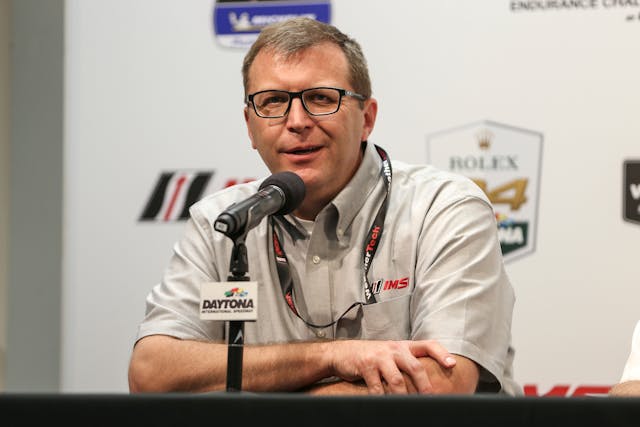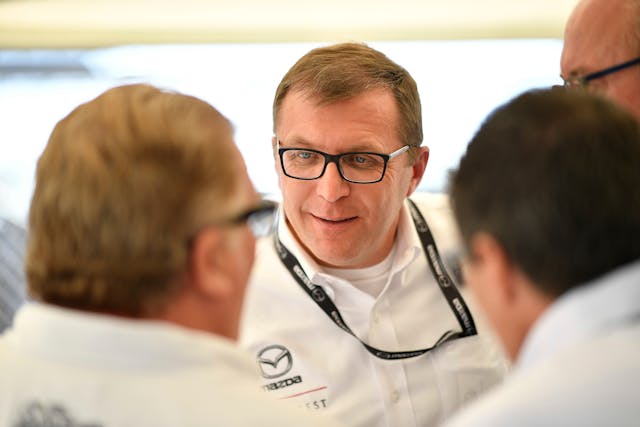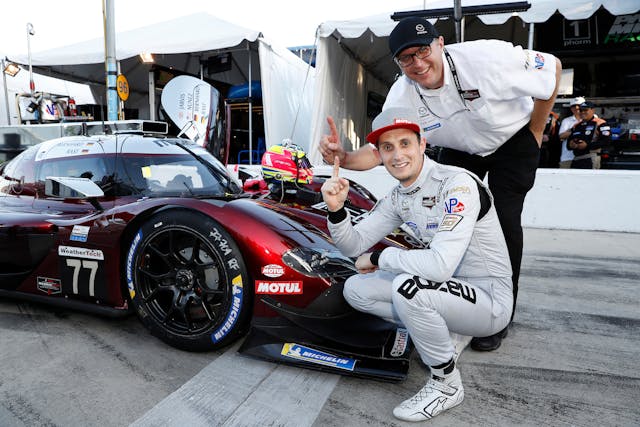The cowboy who became a sheriff: John Doonan steers the IMSA ship through troubled waters

It’s January, 2019, at the mandatory “Roar Before the 24″—a long-weekend test session prior to the Rolex 24 at Daytona—and John Doonan is one pissed-off cowboy.
This is remarkable, because John Doonan never gets angry. He’s the 6-foot, 3-inch gentle giant who runs Mazda Motorsports, and his reputation is one of even temper and lowered voices. But today, not so much. Doonan has spent close to $1 million to get his two-car Mazda Daytona Prototype international—that’s DPi, the fastest class there is in the International Motor Sports Association WeatherTech SportsCar Championship series – ready for this test, delivering a bunch of drivers, engineers and crew to Daytona International Speedway to benchmark the Mazdas against the other DPi cars. Which is what the Roar is for.
But those other cars are sandbagging. Seriously sandbagging. Here’s why: IMSA has this “Balance of Performance” formula to keep the competition even. If a certain brand of car consistently goes faster than everybody else, IMSA can add weight to the car, or shrink its fuel tank, or mess with the aerodynamics. If a brand goes too slow, that’s reversed, and the brand gets a break. So ultra-conventional wisdom is that you show up for the Roar, and decline to show all your cards. But that doesn’t work for John Doonan, because both the rules and good manners say no sandbagging. Lay the cards on the table and see how fast you can go, just like you will in a couple of weeks at the Rolex 24.
“John Doonan,” claimed one team owner, “is a Boy Scout.” It is said neither as a compliment or criticism, simply as a fact.
So Doonan tells all those Mazda drivers to go as fast as they can, because that’s what you are supposed to do. And they go out and set a 2019 track record that eclipses the old one, set in 1993 by one of Dan Gurney’s Toyota Eagles.
Oh boy, sentient observers observe: John Doonan’s cars are going too fast. They’ll be BoP-eed to the back of the pack on race day. But they aren’t. They aren’t BoP-eed at all. IMSA honors the spirit of Doonan’s flat-out run, rather than the letter of everyone else’s sandbagging, and does the right thing. When the race happens, suddenly the other cars have somehow found a lot of speed to challenge the Mazdas, but those Mazdas are still fastest. They don’t win, but everybody knows they were there.
“I trust the system,” Doonan said at the time.
One year later, starting with the 2020 Roar Before the 24, John Doonan was the system.

During the off season, IMSA President Scott Atherton, who helped guide the merger of IMSA’s Grand Am Series, and the competing American Le Mans Series, retired. And John Doonan was hired to run IMSA. “A dream job,” Doonan said.
And it is, at least for a man who attended his first major auto race, the Sports Car Club of America June Sprints at Road America in Wisconsin, at age 6. As in six weeks. “I was there, in my little bassinet,” he said, though it is hard to imagine Doonan ever fitting into a little bassinet. His father, a stockbroker, was racing SCCA in a Volkswagen. His grandfather raced, too; more about that in a moment.
Doonan spent a lot of time around cars in general, race cars in particular. His dad’s last Volkswagen Type 1 (aka Beetle) race car happened because it broke down in front of their house in Chicago. It was the winter of 1974, and it was snowing. His father offered to help the woman who was driving, but she said she just wanted to get rid of the car. So they gave her $150, called her a cab, pushed the broken Bug into their garage, and turned it into a racer.
Doonan went off to college to play basketball, and when he was done he ended up at Mazda, working on the retail side. He and his father had become enthralled with Mazda in general, the brand-new 1979 RX-7 in particular, and had raced one. Doonan went to racing school in 1995 and competed briefly, finishing his career in the open-wheeled Formula Mazda series.
In 2004, Doonan moved to Mazda’s racing operations as the manager of motorsports team development. In May of 2011, Doonan became director of Mazda Motorsports, replacing racer Robert Davis, who was promoted back over to the business side.

Doonan quickly began making a difference. Mazda’s racing customer division caters to a wide variety of amateur competitors, most of whom are driving Miatas. He blended everyone into one massive family, supporting their efforts at the track. Meanwhile, Mazda was busy increasing its pro efforts, both in the Grand Am and American Le Mans Series. On January 25, 2014, those two sanctions merged into a single effort for the Rolex 24 at Daytona as the Tudor United SportsCar Championship, which is now the WeatherTech championship. This merger of equals is called neither Grand Am nor ALMS, but rather IMSA, after the sanctioning body formed in 1969 by John and Peggy Bishop.
Also debuting that day: The Mazda Skyactiv-D Prototype, the company’s first true foray into IMSA Prototype racing. Ambitious on multiple levels, Mazda, which had dominated in its production-based GT race cars, put a diesel engine in the Skyactiv-D, heralding the widespread availability of diesel engines in its passenger cars, for which we are still waiting.
It was a train wreck. The two Mazda Prototypes finished 56th and 57th at that first Rolex 24. That season did not get any better, nor did the next season. The diesel was a disaster. It didn’t help that the team was fielded by SpeedSource, which had massive success with Mazda’s GT cars, but had no real experience with either diesels or prototypes.
Eventually, Mazda allowed them to dump the diesel, returning to the 2.0-liter turbo four-cylinder that Mazda had supplied to the Dyson LMP1 team in the old American Le Mans Series. The car and the team got better and better, but so did everybody else.
Through it all, Doonan was the keep-your-chin-up point man, and he was convincing. The crew worked very hard for him. Time after time he had to go meet the media, race after race, and tell them why a $3 part broke and put the car out of the race. “A character-building time,” he said. And then he’d give a Knute Rockne, get-em-next-time speech that was fraying at the edges.
But the Mazdas got faster and faster, and more reliable, and the downright horrible luck that had followed the Mazda teams like the Grimmest Reaper you can imagine finally receded, and on June 30 of 2019, at the Sahlen’s Six Hours at Watkins Glen, New York, Mazda not only took its first WeatherTech series Prototype win, but a one-two finish. And they kept on winning.

Mazda was back. Technically, Doonan’s job was done. This did not escape the attention of Jim France, the head of everything NASCAR-related and the son of NASCAR founder “Big Bill” France whose Grand Am series had turned out to be the senior partner in the Grand Am/ALMS merger. Scott Atherton and Ed Bennett, who had worked for ALMS prior to said merger, agreed with France that Doonan would be the ideal replacement for Atherton, “and when that call came,” Doonan recalled, “it was Jim and Ed, the best in the business. You answer the phone.”
Before he took the job, he called Mitch Bishop, son of John and Peggy Bishop, who—along with Bill France—founded IMSA in 1969. “I wanted to let him know that my vision for IMSA was to grow it, but only on the foundation the Bishops and the France family built for it. Which is obviously integrity, but also the opportunity for people to go racing at any level, safely and affordably.”
Doonan has reached out to the SCCA, the world’s largest car racing club, to help create pathways to the Rolex 24 for not only amateur racers, “but corner marshals and race officials to help all of us take racing into the future. We have to grow from the grassroots side.”
He had a great coming-out party at the 2020 Roar Before the 24—where, incidentally, new technology was used to help officials tell if a car is sandbagging—and at the Rolex 24. It was there that IMSA, the World Endurance Championship, and the Federation Internationale de l’Automobile, which controls the 24 Hours of Le Mans, announced plans for the new Le Mans Daytona hybrid, or LMDh, a Prototype car that would be legal to race both in IMSA and the WEC, making it possible for a team to hit a trifecta—Daytona, the Mobil 1 Twelve Hours of Sebring and the 24 Hours of Le Mans. That hasn’t been possible for decades.
Everyone wants to race at Le Mans for the overall championship, and the idea that it could be done in IMSA-legal equipment has sent more than a dozen manufacturers to the table. Despite COVID-19, “they haven’t left,” Doonan said. Indeed, “IMSA is already a showcase for manufacturers, with 18 different ones racing at some level in our series.”
After Daytona, the honeymoon was over for Doonan and IMSA: pandemic concerns have pushed back the LMDh at least a year to 2023. All season, it was a monumental effort to get as many races in as possible—after Daytona in February, IMSA didn’t race again until July 4, and after that, the series had to gerrymander the schedule to exclude states where no racing was allowed during lockdowns, such as New York, eliminating the Six Hours at the Glen and postponing the Twelve Hours of Sebring to November.
“It taught us a lot about having to execute our events in a different manner,” Doonan said. “We missed having the fans in the paddock and on the grid walk, but we’ll get that back as soon as we can. But the fact that we managed to get the season in like we did was really special,” It was also, for Doonan, baptism under fire. For 2021, “We have a good system in place that is likely to operate in a very similar manner, maybe with even more strict protocols given what is happening in the marketplace,” he said. That starts this weekend, with the 2021 Roar Before the 24.
Doonan, a dedicated family man, is having to spend a lot of time by himself in Daytona Beach, commuting home to Chicago as often as he can (“A 17-hour drive,” he said, “not bad!”) until everyone is ready to move to Florida.
He is also a student of motorsports history, including his own family’s history. He found his father’s Volkswagen Type 1 Bug in Colorado, still racing, and made sure the owner knows that he will only need to make one call when it’s time to sell.
So that’s his father’s car handled. What about his racing grandfather? “I was sitting on the pit box at Daytona a few years ago—I still worked for Mazda—and I get an email from a man who said, ‘I’m helping a widow sell a car that you used to own.’” It was a 1947 Kurtis Kraft midget. “I didn’t own the car, but my grandfather did, who was also named John Doonan. I used to sit in that car as a little kid in my grandpa’s garage, pretending that I was racing it. I started tearing up right there.”
Doonan started the process of making sure the car was the same one, and it was, and he bought it. It was close, in Jacksonville, on the mezzanine level of a stock car racer’s garage on display, in museum condition, because that’s where the racer bought the midget—from the Volo Auto Museum in Illinois, “where it had been on display less than an hour from my house, and I never knew.”
Now the man owns his grandfather’s midget, currently sitting in the shop of a Daytona racer, where Doonan can go look at it.
“I can’t come close to fitting into it. But I look at that car, and I think, ‘We’re both in the right place now.’”

